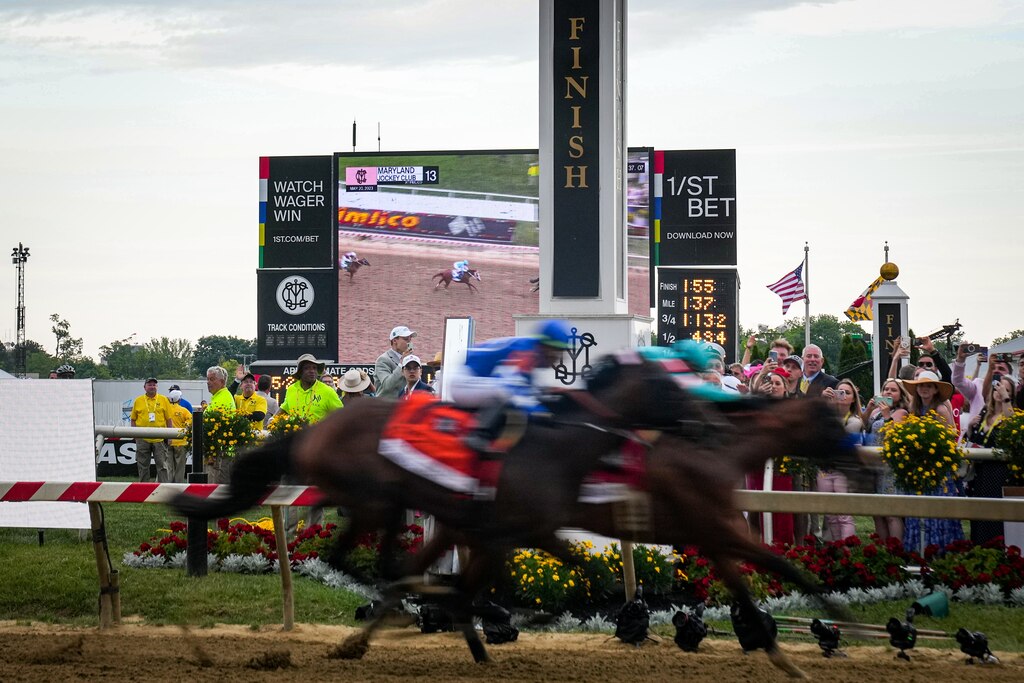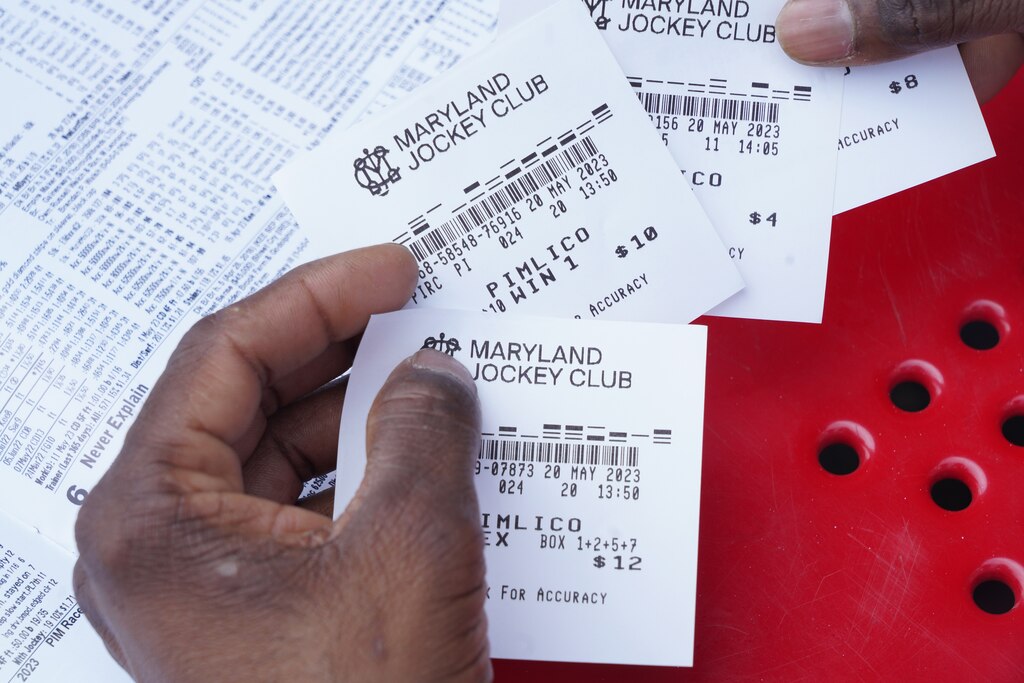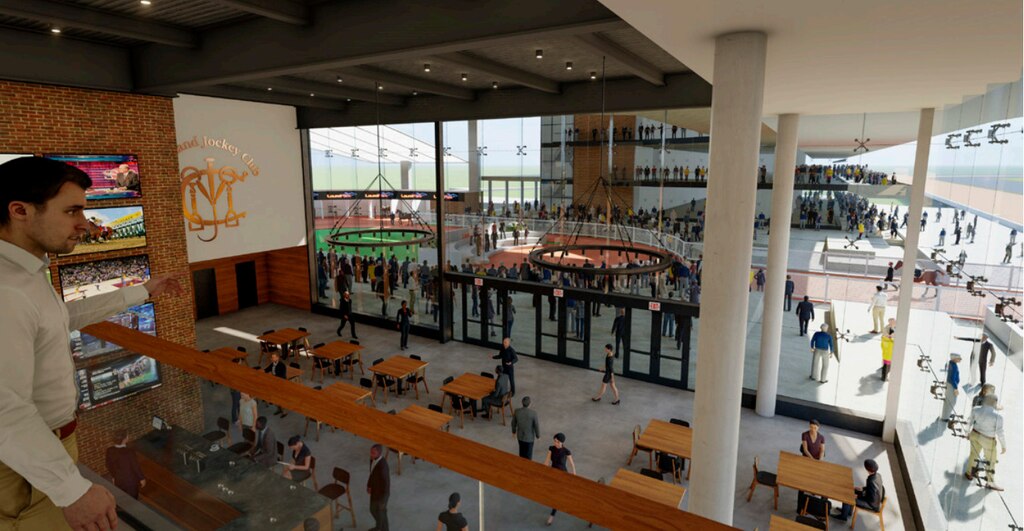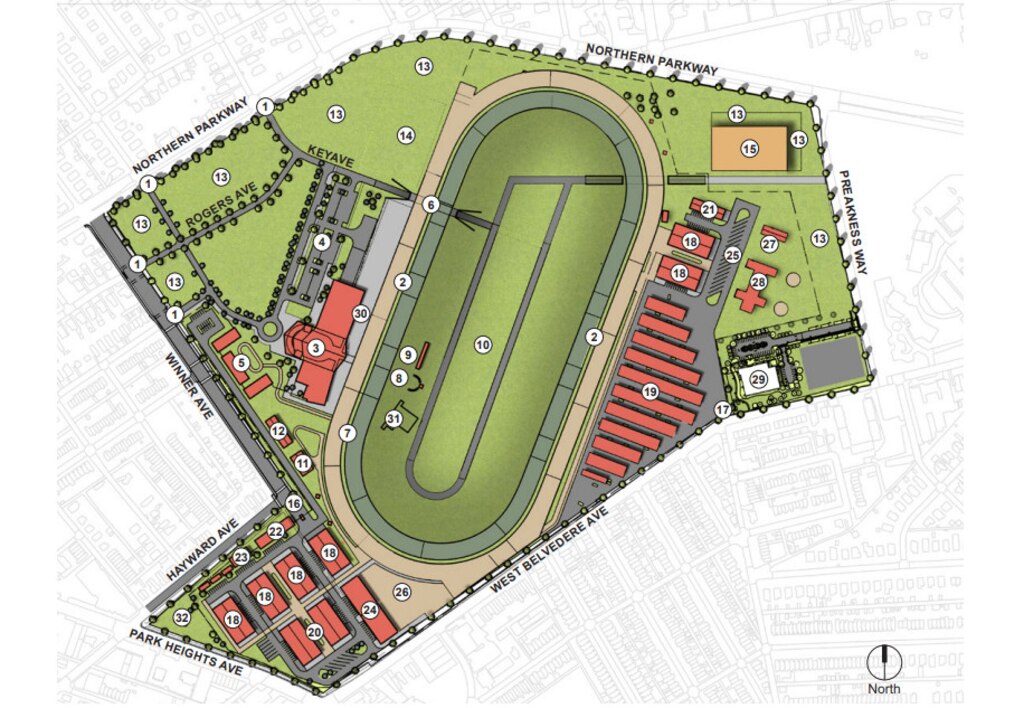A new plan put forth by the Maryland Thoroughbred Racetrack Operating Authority would significantly alter the landscape of horse racing in the state, consolidating racing at Pimlico Race Course in Northwest Baltimore and creating a state-run nonprofit to oversee day-to-day operations of the track, similar to the setup of the New York Racing Association.
Under the terms of the agreement, 1/ST Racing and Gaming, the owner of Pimlico Race Course and Laurel Park, would donate Pimlico to the state while retaining ownership of Laurel Park, according to an official familiar with the negotiations.
Racing operations would be transferred to the new nonprofit at the start of 2025, but the Preakness Stakes — the second leg of horse racing’s Triple Crown — would be run at Laurel until 2027 while Pimlico is overhauled, the official said. Once the project is completed, 1/ST would retain ownership of Preakness and license it to the new state organization. The Laurel Park parcel would then be available for redevelopment.
A separate facility would have to be built to house racehorses and give them a place to train. The new Pimlico comes with a price tag of $274 million to $284 million, while the training facility would cost about $113 million — in line with $400 million in state subsidies previously set aside for the renovation of Pimlico and Laurel.
Here are the biggest takeaways from two reports released by the authority, which was convened last year to assess the progress of stalled redevelopment projects at the two tracks.

The goals for a state-run nonprofit overseeing horse racing
A report by the firm Crossroads Consulting suggests starting a nonprofit similar to the New York Racing Association to run 140 to 165 live racing days per year, which is in range with what the Maryland Jockey Club has run over the last decade.
Read More
The firm made recommendations for improving the racing product. The state-run nonprofit should target increasing race purses — the prize money for each race — by 30% to an average of $60,000, below the purses in New York but in line with other Mid-Atlantic states. Field sizes — the number of horses running in a given race — should go up 15% to an average of 8.5, the report says. In 2022, the average purse in Maryland was $44,035 and the average field size was 7.4.
New strategies could be developed and marketed, such as boutique meets like those run at Kentucky Downs, Keeneland and Del Mar with high-profile stakes races, to increase on-track wagering.
“While the levels of live on-track wagering are unlikely to ever return to historical levels due to general trends in the horse racing industry and the proliferation of other forms of gambling, the success demonstrated in other states indicate[s] the potential to develop strategies to reverse the trend of declining attendance and live on-track wagering at Maryland thoroughbred tracks,” the report says.
The nonprofit could follow steps taken by NYRA and Churchill Downs to partner with other gambling providers such as BetMGM, FanDuel and DraftKings to attract more bettors from outside the state.
Additionally, the state should increase the incentives it offers to Maryland horse breeders by 15% to 20% to be competitive with other states and increase the stock of horses. Breeding in the state has declined in recent years, according to the report, although Maryland’s market share in that sector of the industry has remained steady.

The financial outlook of racing in Maryland
Racing in Maryland is financially viable under current market conditions, according to the Crossroads report, but there’s not a sufficient return on investment to entice a for-profit entity to invest in the existing facilities.
The plan to consolidate racing at Pimlico should cut costs, the report says, and “improved operations of the Preakness present significant opportunities for improved profitability.”
From 2013 to 2022, the state’s handle — the amount of money wagered on races — has gone up 44.7%, from $444.7 million to $541.9 million, according to the report. But it has started to decline in recent years since reaching a high of $580.9 million in 2019.
Simulcast streams of Maryland races, allowing bettors outside the track to wager on the races being run at Laurel and Pimlico, accounted for 88.2% of the handle in 2022, the report says.
Under a 2008 state law to legalize slot machines, racetracks were given a 7% fee from the gross revenue from slots for a Purse Dedication Account, of which 80% goes to the thoroughbred industry and 20% goes to the standardbred harness racing industry. The percentage has since been revised to 6%, and a small portion of the funds is set aside for breeding incentives, the report says.
The industry is “highly reliant” on these funds to offer competitive purses, the report says. In 2022, money from casinos contributed $55.4 million toward purses, or 81.9% of the prize money.

How a new Pimlico would look
Two plans for redeveloping Historic Old Hilltop are being proposed in a report by the design firm Populous. Both include a 137,085-square-foot clubhouse, with a theater around the winner’s circle and paddock, seating boxes, sports bars, a sports book, a simulcast betting facility and flex spaces. An additional outdoor space would provide 50,250 square feet of terraced seating.
The building would incorporate elements of the existing clubhouse and grandstands, such as the bas relief of “The Great Race” run in 1877, sculptures, artifacts, murals and wood from the Old Grandstand.
“The venue offers the capacity to host large and small events including but not limited to large racing events, off track betting, full-service food and beverage, and community and private events,” the report says. “This provides the opportunity to maximize flexibility and revenue streams.”
Both proposals would also have a 1-mile dirt track and 7/8th-mile turf track, “creating consistent widths throughout the length of the tracks and more gradual turns,” the report says.
The biggest question would be how the site is oriented.

One proposal would leave the track in its current alignment but reconstruct the racing surfaces to “correct irregularities in the current geometry and incorporate modern transition turns, in an effort to create the safest possible racing conditions,” the report says. The new clubhouse would be constructed in roughly the same space where the current one sits.
The site would allow for 560 stables — 320 from barns already on-site that would be renovated and another 240 from newly constructed barns. But the existing pinch points along Northern Parkway and Belvedere Avenue would keep in place some of the challenging aspects of the Pimlico site, which is difficult to navigate and has the stabling areas divided by the track. About 15.25 acres would be available for development, but the shape of the parcels would be more restrictive.

The second proposal would rotate the track so it runs parallel with Northern Parkway and place almost all of the barns along West Belvedere Avenue, better orienting Pimlico with the surrounding neighborhoods, creating more uniform parcels for development and allowing for a “grand entrance experience” to be built at the site.
About 16.25 acres near the track would be available for development, and the parcels would be more uniform. State officials also mentioned the potential for a hotel, parking garage and retail space, but there are no concrete plans in the report.
In both plans, Preakness Day capacity would be about 70,000 people with the new facilities and temporary spaces added for the event.
A 2018 plan for the racetrack also proposed rotating the track, but it called for a 409,000-square-foot clubhouse that would have functioned as a multi-use event space. The infield would also have sports fields available to the community. Under that framework, however, Laurel Park would have continued to serve as the state’s primary track and Pimlico would have held races only during the Preakness meet.
The location of a new training facility
The training center would also have a 1-mile dirt track and 7/8th-mile turf track, along with 640 stalls for horses, a veterinary center and administration building with a track dining area, off-track betting, a viewing plaza and conference space.
Eight sites were considered and graded based on location, cost, infrastructure, topography and natural resources, among other factors. The old Bowie Race Track site owned by 1/ST, Shamrock Farm in Woodbine and Mitchell Farm in Aberdeen were ranked as the most favorable options, with Shamrock Farm and Mitchell Farm tying for the highest score.
Shamrock, a 600-acre horse breeding farm in Carroll County, is less than 40 miles from Pimlico and is close to where many horse trainers live. It would cost an estimated $5.8 million to clear and grade the 155 acres allotted for the training center and make infrastructure improvements, the report says.
Mitchell is the furthest from Pimlico but has relatively flat terrain, and a nearby industrial development could allow for shared infrastructure upgrades. The site has 97 acres, with room for expansion. Preparing the site for construction would cost $3.3 million to $3.7 million, the report says.
The City of Bowie is slated to receive the former Bowie Race Track property at the end of this year and has formed a committee of residents and representatives of Bowie State University to consider recreational uses for the land. One proposal for the training center has sports fields in the infield of the track, which could draw more community support.
The site is considered to be in poor condition and would need $3.7 million to $4.5 million in work to get ready for construction. And one-third of the property, which has streams and forests, has been flagged as a potential protection area, the report says.




Comments
Welcome to The Banner's subscriber-only commenting community. Please review our community guidelines.